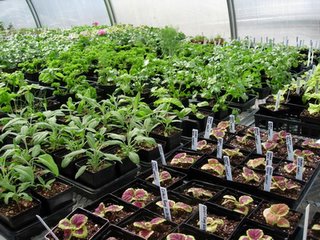Seed starter's guide

Starting seeds indoors can be simple or elaborate, ranging from a few seeds in little pot or tray on a window sill to elaborate growing setups like this greenhouse at Southern Maine Community College, where students are growing annuals and herbs to sell at the Flower Show next weekend.
Here's a list of tips:
* Buy small packets of seeds (Pinetree Seeds specializes in small packets) and plant a few more than you think you'll need to take into account losses and less than 100% germination rates.
* Read the packet and follow directions: if seeds should be started outdoors, wait--some things don't like transplanting.
* Plant in small trays, peat pots, or Jiffy pellets and transplant at least once to larger pots.
* Use seed starting mediums, which contain vermiculite, peat and soil, and hold lots of water.
* Follow directions for planting depth, light, and temperature. Warm-season crops like warm soil. The top of the refrigerator is a good place to start warm-season crops.
* Provide plenty of light--at least 12 hours a day--once your plants have sprouted. They need lots of blue and red wavelength light--ordinary incandescent light bulbs are lacking.
* When the seedlings are getting top heavy for the starter pots, think about transplanting.
* Water regularly. Do not feed until you see at least four leaves on the plant, and then feed weakly.
* If you see a whitish fungus, spray with cool chamomile tea immediately.

0 Comments:
Post a Comment
<< Home